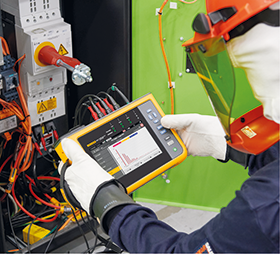

Saving energy and minimising energy waste are two of the most critical aspects of energy use. Energy saving means looking at your power consumption rates, and developing a power quality management energy-saving plan.
Benchmarking electrical energy consumption
The first step in developing a power quality management programme is benchmarking your current electrical energy consumption. Through an initial survey, you can look for quick and easy solutions to start with. Track areas that contribute to your energy usage outside significant assets, like supplementary electrical heating, lighting being left on, and computers not being switched off.
Once you’ve identified these quick wins, continue with more detailed studies. Run load studies on assets throughout the area using the Fluke 1777 three-phase power quality analyser. These measurements can show where you could see significant energy-saving opportunities, such as switching off some systems during the night.
Advanced power quality considerations
The next step in reducing energy consumption is to see where energy waste arises. One area is conductors. As current flows through conductors, some energy will turn into wasted energy as heat. What is the best solution? Consider the conductor sizing. Following the National Electric Code
Wasted power
These codes and guidelines are fine for new installations, but don’t always work out ideally once the cabling installation is completed and the loads are installed. Over time, the equipment may change with additions or adjustments; moves and age can significantly affect waste energy. Key areas where energy waste may occur are related to your power quality, especially voltage regulation, harmonics, power factor, and unbalanced loads.
Voltage regulation works to reduce energy consumption in voltage-dependent loads. It reduces or controls the voltage levels within the equipment manufacturer’s specifications to return energy savings. As more efficient loads are installed at a transformer, the voltage in the system may rise or be incorrectly controlled. To catch voltage regulation issues, use a Fluke 1777 power quality analyser to look for transient voltages and voltage imbalance. Both issues can lead to failure, unplanned downtime, and expensive repairs.
Harmonics distort the voltage and current so that the ideal sine wave for voltage is not maintained. One of the most recognised effects of harmonics in electrical systems is the excess heat they create in the conductors carrying them. This results in overheating in phase and neutral conductors, known as ‘triplen harmonics’.
The additional heat causes cable runs, motor windings, and transformer issues. The overheating can cause significant damage or complete failure, either of which could lead to unplanned downtime and expensive repairs. To measure and diagnose harmonics, use a Fluke 1770 series three-phase power quality analyser.
The additional heat due to an unbalanced load causes issues with cable runs, motor windings, and transformers. The overheating can cause significant damage or complete failure, either of which could lead to unplanned downtime and expensive repairs. To measure and diagnose harmonics, use a Fluke 1770 series three-phase power quality analyser.
Once power quality studies reveal areas where energy is being wasted, you can take steps to fix the issues:
• Set up a preventive maintenance routine so you can continue to measure against your benchmark and catch issues as they arise.
• Install harmonic filters on loads that add to your facility’s harmonic distortion.
• Address the sources of unbalance. This may mean setting up a repair or replacement schedule for large motors with mechanical unbalance issues.
• Mitigate unbalanced load issues. In some cases, this may mean adjusting single-phase loads to be more equally distributed across the phases.
• Replace blown fuses where necessary.
Product: https://bit.ly/3HsyTZJ
| Tel: | +27 10 595 1824 |
| Email: | sales@comtest.co.za |
| www: | www.comtest.co.za |
| Articles: | More information and articles about Comtest |

© Technews Publishing (Pty) Ltd | All Rights Reserved